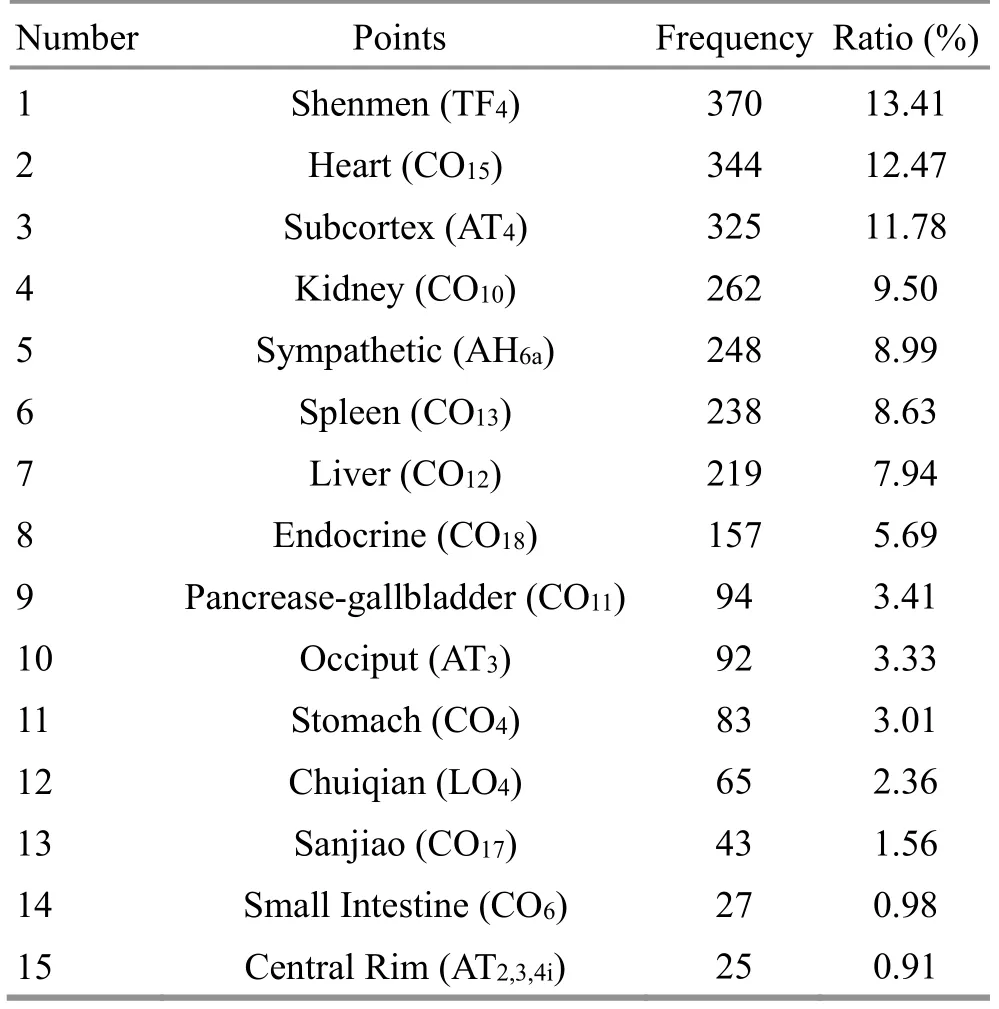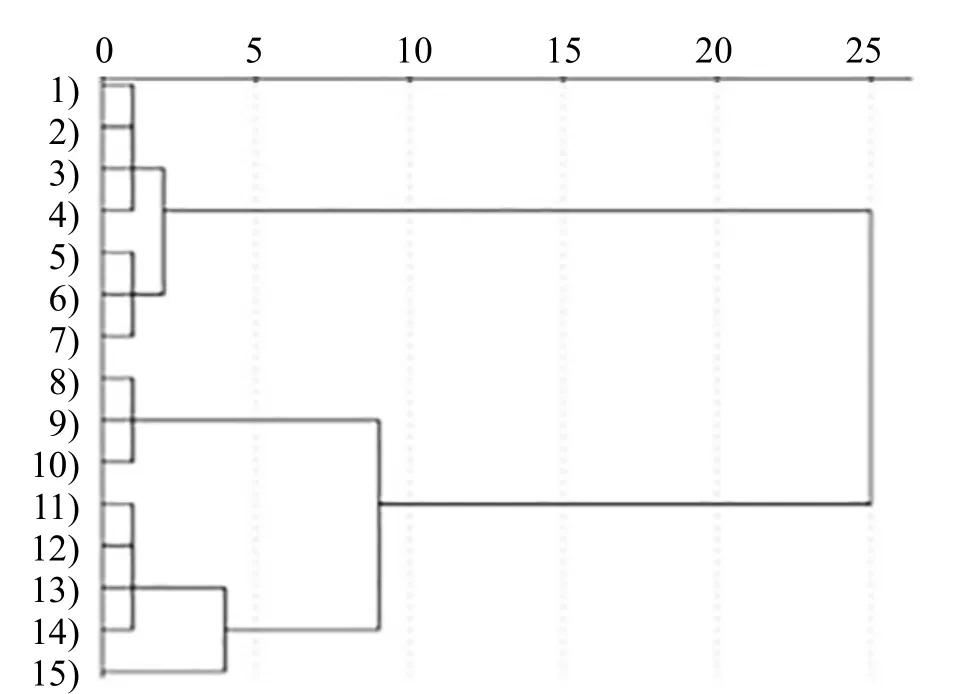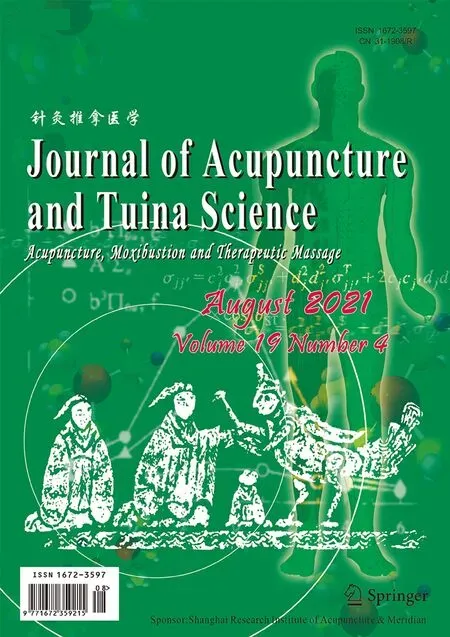Modern literature study of auricular point therapy for primary insomnia
Yang Qiu-hong (杨秋红), Xie Chen (谢晨)
1 School of Acupuncture-moxibustion and Tuina, Shanghai University of Traditional Chinese Medicine, Shanghai 201203, China
2 Jiangwan Hospital, Hongkou District, Shanghai, Shanghai 200434, China
3 Shanghai Research Institute of Acupuncture and Meridian, Shanghai 200030, China
4 Yueyang Hospital of Integrated Traditional Chinese and Western Medicine, Shanghai University of Traditional Chinese Medicine,Shanghai 200437, China
Abstract
Keywords: Auricular Point Sticking; Points, Auricular Acupuncture; Insomnia, Primary; Cluster Analysis; Correlation Analysis; Acupoint Compatibility; Literature Research
Insomnia is a subjective experience manifested by a shortened sleep period or inability to stay deep enough in sleep. In mild cases, there will be difficulty falling asleep or sleeping soundly, easy to be awake during sleep or lack of inability to return to sleep after waking up, while in serious cases, people may stay up all night[1],which greatly affect daily life and work. Primary insomnia (PI) refers to a sleeping disorder in which frequent and persistent difficulty falling or staying asleep leads to sleep dissatisfaction, which may impair social function more or less[2]. Hyperarousal plays a crucial role in the pathogenesis of PI, presenting as increased physical, cognitive and cortical activities[3].
To date, there are a variety of treatments for PI. In Western medicine, there are pharmacological treatment such as benzodiazepines,nonbenzodiazepines, and drugs for anti-anxiety and anti-depression, and non-pharmacological treatment including health education, phototherapy, psychological and cognitive behavior therapy[4]. In traditional Chinese medicine (TCM), there are herbal medication[5], Chinese patent drugs (e.g. Wuling capsules)[6], Chinese therapeutic massage (tuina)[7]and acupuncturemoxibustion treatment[8]. Acupuncture-moxibustion therapy includes acupuncture therapy, moxibustion,auricular point therapy, thread-embedding therapy[9],music therapy[10]and acupuncture combined with medication[11-13]. Of which, auricular point therapy can produce significant efficacy in treating PI with easy-to-operate procedure, and has been widely spread in clinic[14]. Auricular point therapy treats PI through stimulating specific regions on the ear to regulate the function of Zang-fu organs and balance yin-yang[15-18].This study summarized and analyzed modern literature targeting auricular point therapy treating PI, aiming to find the rules in acupoint selection and grouping in treatment of PI with auricular point therapy.
1 Materials and Methods
1.1 Search strategy
Common databases were searched using computer,including China National Knowledge Infrastructure(CNKI), Wanfang Academic Journal Full-text Database(Wanfang), Chongqing VIP Database (CQVIP), PubMed,Springer and Ovid. Main search terms were ‘insomnia’,‘sleeplessness’, ‘sleep’, ‘sleeping disturbance’, ‘auricular point’, ‘auricular acupuncture’ and ‘ear’. Subject, title and key words were searched, with ‘AND’ and ‘OR’ as conjunction to develop logic query. For example:‘(Title=Insomnia OR Title=Insomnia OR Title=Sleeping disturbance, Title=Auricular point OR Title=Auricular acupuncture OR Title=Ear)’, and then ‘Title’ was replaced by ’Subject’ or ‘Key words’ for another retrieval.
1.2 Inclusion criteria
Modern studies observing auricular point therapy alone or using it with other treatment together to treat PI; published between January 1, 1998 and January 31,2020; clinical studies, including randomized controlled trial (RCT) and controlled clinical trial (CCT); the participants were diagnosed with PI, according to the diagnostic criteria for chronic insomniainChinese Classification and Diagnostic Criteria of Mental Disorders[19],Criteria of Diagnosis and Therapeutic Effects of Diseases and Syndromes in Traditional Chinese Medicine[20], and international classification of sleep disorders (ICSD-3)[21], etc.; intervention groups used auricular point alone or a joint treatment involving auricular point therapy, while control groups adopted other treatments rather than auricular point therapy,and the joint treatment here should contain no more than 3 methods.
1.3 Exclusion criteria
Duplicate studies; those adopted a joint treatment involving over 3 methods.
1.4 Data processing
Two reviewers independently screened studies rigorously following the inclusion and exclusion criteria.Any disagreement would be solved through discussion.The included studies were input onto computer via Excel for primary data analysis, including the name of the journal, clinical efficacy, acupoint frequency and distribution, etc. SPSS 21.0 and Clementine 12.0 were used to conduct cluster and correlation analyses among the points that appeared over 10 times. Hierarchical cluster was adopted for cluster analysis and Apriori algorithm was used in correlation analysis.Measurement data that were normally distributed were expressed as mean ± standard deviation (±s) and processed usingt-test; those not normally distributed were expressed as median (interquartile range) [M(IQR)] and processed using non-parametric test.P<0.05 was taken to indicate statistical significance.
2 Results
2.1 General results
2.1.1 Number of studies
After screening, a total of 386 studies were included,for an in-depth data mining of the selection and distribution of auricular points used in treating PI and to summarize the general rule.
2.1.2 Screening and sources of the studies
Of the included 386 studies, Shiyong Zhongyiyao Zazhi and Zhongyi Linchuang Yanjiu contributed 27 each,Neimenggu Zhongyiyao and Zhongguo Minjian Liaofa contributed 25 each, 20 studies were from Shanghai Zhenjiu Zazhi, 18 were from Guangming Zhongyi, 14 from Shaanxi Zhongyi, Yunnan Zhongyi Zhongyao Zazhi and Zhongguo Zhen Jiu contributed 12 each, Sichuan Zhongyi and Zhongguo Yiyao Zhinan contributed 11 each, 10 from Anmo Yu Kangfu Yixue and 10 from Xin Zhongyi, and the other involved journals all contributed less than 10 studies.
2.2 Comparison of therapeutic efficacy
The involved treatment methods were sorted and analyzed and finally 6 treatment methods each with a total sample size >1 000 were compared. The rest methods, such as joint Chinese and Western medication,electroencephalogram (EEG), hyperbaric oxygen,psychotherapy, were not listed in this research because of a small sample size. Western medications included sedatives and hypnotics. Chinese medication included orally taken ones and externally used ones such as foot bathing. In terms of Pittsburgh sleep quality index(PSQI), the difference in the score after auricular acupoint treatment was more significant than that after Chinese medication treatment (P<0.05), but less significant than that after auricular point treatment plus acupuncture-moxibustion and tuina (P<0.05). However,since the interaction inside the joint treatments is unknown, it is improper to say that auricular point treatment plus acupuncture-moxibustion and tuina produces more significant efficacy than using auricular points alone in treating PI (Table 1). In this study, only the differences before and after treatment were compared since their baselines were not statistically equal across the 6 methods.

Table 1. Comparison of PSQI before and after treatment [M (IQR), point]
2.3 Frequencies of auricular points
The auricular points used in the included studies were statistically analyzed. Regarding the distribution,auricular concha was the most commonly used, which was 1 500 times, followed by the antitragus which was 474 times and triangular fossa which was 387 times.The analysis of the points that appeared over 20 times in the studies using auricular point therapy as monotherapy showed that Shenmen (TF4) was the most commonly used (370 times), followed by Heart (CO15)(344 times), Subcortex (AT4) (325 times), Kidney (CO10)(262 times) and Sympathetic (AH6a) (248 times). Please see Table 2 and Table 3.

Table 2. Auricular points distribution

Table 3. Frequency list of auricular points
2.4 Correlation analysis of acupoints
Correlation analysis was performed for the points with a frequency ≥20 and those with a confidence of 100% and support ≥28% were paired and listed(Table 4). Support degree refers to the ratio of the former item to the whole event and the rule support degree means the ratio of the former and latter items to the whole event; confidence degree refers to the ratio of rule support degree to support degree.Statistical analysis of the acupoint pairs with a confidence degree ≥28% showed that the support was all 100%, suggesting that it was 100% that the former item appeared in all included studies. The acupoint prescriptions that contained Shenmen (TF4), Liver (CO12),Sympathetic (AH6a) and Heart (CO15) simultaneously accounted for 33.85%, indicating that there was a high possibility that these four points were used together.Then, it was the prescriptions that contained Shenmen(TF4), Liver (CO12), Spleen (CO13), Kidney (CO10) and Subcortex (AT4) concurrently, followed by those containing Shenmen (TF4), Liver (CO12), Sympathetic(AH6a), Subcortex (AT4) and Heart (CO15).

Table 4. Correlation analysis of auricular points in treating PI
2.5 Acupoint clusters
Icicle plot revealed 6 clusters of auricular points, i.e.Central Rim (AT2,3,4i), Small Intestine (CO6) and Sanjiao(CO17); Chuiqian (LO4), Stomach (CO4), Occiput (AT3) and Pancrease-gallbladder (CO11); Endocrine (CO18); Liver(CO12), Spleen (CO13), Sympathetic (AH6a) and Kidney(CO10); Subcortex (AT4) and Heart (CO15); Shenmen (TF4).The details are shown in Figure 1.
Dendrogram divided the acupoints into two groups:Heart (CO15), Subcortex (AT4), Shenmen (TF4),Sympathetic (AH6a), Spleen (CO13), Kidney (CO10), Liver(CO12) and Endocrine (CO18); Occiput (AT3), Stomach(CO4), Pancrease-gallbladder (CO11), Chuiqian (LO4),Small Intestine (CO6), Central Rim (AT2,3,4i) and Sanjiao(CO17). The first group was the major points in treating insomnia while the second group was the commonly used adjuvant points. The details are shown in Figure 2.

Figure 1. Icicle plot demonstrating auricular acupoints clusters in treating PI

Figure 2. Cluster analysis dendrogram of auricular acupoints in treating PI
2.6 Frequency of auricular points for different patterns
Despite single use or joint use of auricular acupoints,the main patterns recorded on the pertinent PI studies were dual deficiency of the heart and spleen, liver depression transforming into fire, heart-gallbladder qi deficiency, heart-kidney disharmony, internal harassment of phlegm-heat, stomach disharmony, yin deficiency with effulgent fire, liver qi depression,stomach-intestine heat, ascendant hyperactivity of liver yang, and yang deficiency. Of which, dual deficiency of the heart and spleen was the most commonly studied pattern, followed by the pattern of liver depression transforming into fire. The analysis of auricular points whose frequency ≥10 given different patterns,Shenmen (TF4) and Subcortex (AT4) were always taken as the major points, assisted by other points based on pattern differentiation. The details are shown in Table 5.

Table 5. Frequency of auricular acupoints in different patterns
3 Discussion
PI can induce many diseases, such as endocrine disorders, anxiety, depression, etc., and may aggravate some primary diseases including coronary heart disease and hypertension[22]. Therefore, PI requires efficient treatment. TCM holds that insomnia results from disharmony between yin and yang, yang failing to enter yin, and its treatment principle should be to regulate yin and yang[23].
3.1 Clinical efficacy and evaluation of auricular points in treating PI
Auricular point therapy is a crucial part of TCM, and its theory of treating diseases is mainly related to meridians, as of the twelve ordinary meridians, some go straight into and some go round the ear[24]. In addition,the ear is closely connected with the physiology and pathology of Zang-Fu organs[25]. In 1888, Zhang Zhen-jun, a medical scientist in Qing Dynasty, put forward the theory that ‘the back of the ear can be divided by the five Zang organs’, and drew a diagram for it, which is the earliest diagram of auricular points so far[26], and has also enriched the TCM theory about auricular points. At the same time, modern medical research shows that there are abundant nerves,lymphatic vessels and blood vessels in the auricle,which are interwoven into a net. The auricle connects with various parts of the body through these nerves.Benign stimulation to auricular points is transmitted from auricle skin to the related nerve nuclei to block and inhibit the pathological excitement and replace the original pathological excitement focus, thus mitigating or eliminating illnesses[27-30].
To date, PSQI has been commonly used to evaluate the overall sleep quality of patients. It estimates the sleep quality of subjects in the last month with 19 self-rating and 5 others-rating items, and is considered effective and reliable. The higher the score, the worse the sleep quality. Domestic scholars believe that PSQI has good internal consistency, retest reliability,construct validity and empirical validity[31]. It is suitable for clinical research in psychiatry and sleep medicine in China. However, some scholars think that the application of PSQI is limited by the lack of severity rating of insomnia[32]. In this review, the PSQI scores in the included studies were re-calculated, finding that auricular point therapy produced more significant efficacy than Chinese medication but it was slightly behind auricular points + acupuncture-moxibustion and tuina. However, since the interaction between the combined therapies is unknown, it cannot be confirmed that auricular points + acupuncture-moxibustion and tuina is superior to auricular point therapy alone in treating PI.
3.2 Data mining technology and result analysis
Compared with traditional methods, data mining technology has the advantage of discovering effective,novel and potentially useful knowledge when dealing with a large number of fuzzy and nonlinear data. Its purpose is to use the discovered patterns to help explain the current behaviors or predict the future results[33], and it has been applied to a variety of studies relevant to acupuncture-moxibustion. Methods of data mining technology include classification, estimation,cluster analysis and correlation analysis[34]. Currently,acupuncture mainly uses data mining technology to discover the law of grouping of acupoints[35-36], explore indications of acupuncture-moxibustion[37], build an auxiliary platform for clinical decision-making[38], dig the experience of famous Chinese medicine practitioners[39],and further discover the application characteristics of acupuncture-moxibustion, the functions of meridians and acupoints, and acupuncture effects[40].
In this study, using data mining technology, we found that Shenmen (TF4) was the most frequently used auricular point in treating PI, followed by Heart (CO15).The auricular points are predominantly distributed on the auricular concha, then it’s the antitragus and triangular fossa. French scholars put forward in 1957 that the distribution of auricular points is like ‘a reversed embryo[41], which accords with the theory of bioholography, providing theoretical basis for treating diseases with auricular points from the perspective of Western medicine. According to the distribution rule of auricular points, the auricular concha corresponds to the chest and abdominal cavity of human body, and there are auricular points corresponding to important organs and functions of human body, such as Heart(CO15), Kidney (CO10), Spleen (CO13), etc. The antitragus corresponds to the throat, internal nose, and adrenal gland, and there distributes auricular points such as Subcortex (AT4). According to holography, the triangular fossa corresponds to pelvic cavity and internal genitalia and there distributes auricular points such as Shenmen(TF4).
The correlation analysis in the study mainly revealed the correlation between acupoints, that is, the probability of simultaneous application of several points.The research showed that Shenmen (TF4) was more likely to be used in combination with Liver (CO12),Sympathetic (AH6a) and Heart (CO15), suggesting that Shenmen (TF4) and Liver (CO12), Sympathetic (AH6a) and Heart (CO15) should be the commonly used auricular point group in treating PI. PI results from the disharmony between yin and yang, yang failing to enter yin. It mainly affects the heart, but the liver, kidney,spleen and stomach are also involved. Shenmen (TF4)and Heart (CO15) correspond to the mind and heart,respectively. Sympathetic (AH6a) has the functions of nourishing yin and clearing heat, benefiting the heart and calming the mind, and regulating gastrointestinal system. Cluster analysis results include icicle diagram and dendrogram. The icicle diagram demonstrated 13 categories of auricular points. When the classification was between 3 and 5, Heart (CO15) and Shenmen (TF4)always formed up one category independently. The dendrogram revealed two types of points. The first type contained Heart (CO15), subcortex (AT4), Shenmen (TF4),Sympathetic (AH6a), Spleen (CO13), Kidney (CO10), Liver(CO12) and Endocrine (CO18); the second type contained Occiput (AT3), Stomach (CO4), Pancrease-gallbladder(CO11), Chuiqian (LO4), Small Intestine (CO6), Central Rim(AT2,3,4i), and Sanjiao (CO17). The first type was the major auricular points in treating PI, and the second was the adjunctive points.
3.3 Rules of auricular points for PI of different patterns
In the literatures of treating PI with auricular points,the most common pattern was dual deficiency of the heart and spleen, followed by liver depression transforming into fire. It is probably because PI mainly affects the heart and liver, and the dysfunction of these two organs should be to blame for the development of PI. The heart is the monarch, and it dominates the mind.If the heart loses its support or the mind is disturbed, it will lead to restlessness and then cause PI. PI is also closely related to the spleen. People living in the modern society usually suffer from mental pressure and over-thinking, which will hurt the spleen and lead to PI.The liver stores blood and soul. Nowadays, the social environment is complex and people are much stressed in life and work. Abnormal emotions may lead to dysfunction of liver in storing soul, and consequently cause PI. Therefore, PI can be treated from the heart,spleen and liver. By analyzing the previous studies of treating PI with auricular points, this paper holds that in treating PI with auricular points, Shenmen (TF4),Subcortex (AT4) and Heart (CO15) should be used as the basic acupoints, along with adjunctive points based on pattern differentiation.
Because of the complex etiology and pathogenesis of PI, there is no cure for it yet in Western medicine, and Western medications may cause drug dependence and increase in dosage. In this paper, through the analysis of the studies on the treatment of PI with auricular points alone or combined with other treatments published in the recent 20 years, we suppose that auricular point therapy can be used as an assistant treatment for PI,either used alone or together with other therapies.
Conflict of Interest
The authors declared that there is no potential conflict of interest in this article.
Acknowledgments
This work was supported by National Natural Science Foundation of China (国家自然科学基金, No. 81804200);Research Project of Shanghai Municipal Health and Family Planning Commission (上海市卫生和计划生育委员会科研课题, No. 20174Y0063).
Received: 29 October 2020/Accepted: 19 December 2020
 Journal of Acupuncture and Tuina Science2021年4期
Journal of Acupuncture and Tuina Science2021年4期
- Journal of Acupuncture and Tuina Science的其它文章
- Regulatory effect of mild moxibustion on P2X3 receptors in spinal cord, anterior cingulate cortex and thalamic ventral posterolateral nucleus of rats with IBS visceral hyperalgesia
- Effect of moxibustion at Shenque (CV 8) on myocardial remodeling and function in exercise-induced fatigue rats
- Clinical study on long-snake moxibustion plus Western medicine in treating chronic heart failure due to heart-kidney yang deficiency
- Muscle regions of meridians warm needling method plus pricking Jing-Well points for blood-letting in the treatment of shoulder-hand syndrome after stroke
- Adjunctive effects of acupressure therapy on pain and quality of life in patients with knee osteoarthritis: an interventional study
- Efficacy and effect on serum VEGF-C of mild moxibustion plus functional exercise for upper-limb lymphedema after breast cancer surgery
